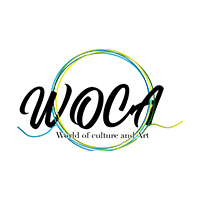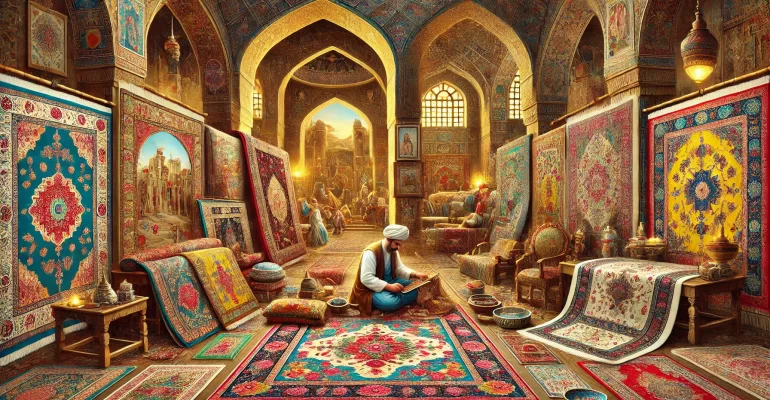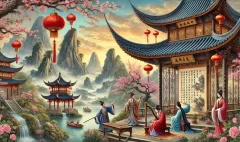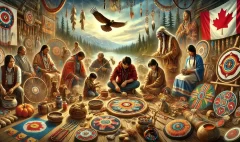The Rich Tapestry of Iranian Traditional Arts
The Rich Tapestry of Iranian Traditional Arts
Iran, a land steeped in history and culture, boasts one of the most diverse and ancient artistic heritages in the world. From the intricately woven carpets of Isfahan to the mesmerizing miniatures of Tabriz, Iranian traditional arts have long served as a testament to the country’s rich cultural identity. These art forms, which have evolved over millennia, are not merely aesthetic creations but are deeply intertwined with the social, religious, and political fabric of Iran.
The significance of Iranian traditional arts lies not only in their beauty but also in their ability to preserve and convey the complex history of the region. Each brushstroke, each knot in a carpet, and each verse of calligraphy tells a story—stories of empires that once ruled vast territories, of spiritual beliefs that shaped the lives of millions, and of the everyday experiences of people who have called this land home for centuries. These arts have been passed down through generations, adapting to the changing times while retaining their core essence, ensuring that the cultural memory of Iran remains alive.

In a world increasingly dominated by globalization, the traditional arts of Iran stand as a resilient reminder of the country’s unique identity. They offer a window into the soul of Iran, revealing the values, beliefs, and traditions that have shaped its people. Whether through the delicate patterns of a Persian carpet or the flowing script of Persian calligraphy, these art forms continue to inspire and captivate, bridging the past with the present. As we delve deeper into the world of Iranian traditional arts, we uncover not only the technical mastery of these creations but also the profound cultural significance they hold, making them an indispensable part of Iran’s enduring legacy.
Historical Overview: A Journey Through Time
The traditional arts of Iran have evolved over thousands of years, shaped by the rise and fall of powerful dynasties that left their mark on the region. Each period in Iran’s history contributed to the development of distinct art forms, reflecting the cultural, religious, and political influences of the time.
The journey begins with the Achaemenid Empire (550–330 BCE), one of the earliest and most influential dynasties in Iranian history. During this period, grand architectural projects, such as the palaces of Persepolis, showcased the empire’s power and artistic sophistication. Relief sculptures, depicting scenes of royal ceremonies and battles, were prominent, setting a foundation for the visual storytelling that would continue in later periods.
Following the Achaemenids, the Sassanid Empire (224–651 CE) emerged as a significant cultural force. The Sassanids are known for their advancements in the arts, particularly in metalwork and textiles. Their intricate designs and luxurious materials became symbols of prestige and were widely admired, influencing neighboring regions as well. This era also saw the development of Persian carpet weaving, a tradition that would become synonymous with Iranian art.

The Safavid dynasty (1501–1736 CE) marked a golden age for Persian arts. Under Safavid rule, Persian miniature painting flourished, with artists creating detailed and colorful scenes that illustrated famous literary works. Calligraphy also reached new heights during this time, with the Nasta’liq script becoming the preferred style for writing poetry and important documents. Safavid architecture, with its ornate tile work and grand mosques, remains a defining feature of Iranian cities.
The Qajar period (1789–1925 CE) continued to nurture traditional arts, but also introduced new influences due to increased contact with Europe. While Persian arts retained their distinct character, European styles began to blend with traditional forms, creating a unique fusion that added another layer to Iran’s artistic heritage.
Through these dynasties, Iranian traditional arts have continuously evolved, absorbing new influences while preserving their core elements, making them a living testament to the country’s rich and varied history.
Persian Miniature Painting: A Window into the Past
Persian miniature painting is one of the most exquisite and detailed forms of art to emerge from Iran’s rich cultural history. These small, highly detailed paintings often depict scenes of courtly life, historical events, and epic tales from Persian literature. Despite their small size, Persian miniatures are renowned for their intricate details, vibrant colors, and delicate brushwork, making them a unique and revered art form.
The characteristics of Persian miniatures are distinct. They typically feature flat, two-dimensional compositions with a strong emphasis on intricate patterns and decorative elements. The figures in these paintings are often stylized, with elongated proportions and expressive postures, set against elaborate backgrounds filled with gardens, palaces, and natural landscapes. The use of bright, vivid colors is another hallmark, with each hue carefully chosen to enhance the visual appeal and symbolism of the scene.

Historically, Persian miniatures were closely tied to the art of manuscript illustration. They were often used to illuminate the pages of important texts, such as the epic poem Shahnameh (The Book of Kings) by Ferdowsi or the works of the famous poet Hafez. These illustrations were not merely decorative; they played a crucial role in bringing the stories to life, allowing readers to visually engage with the narrative. Each miniature served as a window into the world of the text, offering a visual interpretation that complemented the literary work.
The significance of Persian miniatures extends beyond their aesthetic beauty. They are a valuable cultural artifact that provides insight into the social, political, and religious life of the periods in which they were created. These paintings reflect the ideals, values, and worldviews of their time, preserving a rich visual record of Iran’s past. Today, Persian miniatures continue to be admired for their artistic excellence and are considered one of the finest achievements in Iranian art history.
The Elegance of Persian Calligraphy
Persian calligraphy is one of the most revered and elegant art forms in Iranian culture. It is not just a method of writing but an artistic expression that combines beauty and meaning. Over the centuries, calligraphy has evolved into a highly respected art, deeply intertwined with Iran’s rich literary tradition and spiritual beliefs.
There are several styles of Persian calligraphy, each with its unique characteristics. One of the most famous and beloved styles is Nasta’liq. Often referred to as the “bride of calligraphy scripts,” Nasta’liq is known for its flowing, graceful lines and delicate curves. It is the preferred script for writing poetry, especially the works of renowned Persian poets like Hafez and Rumi. The beauty of Nasta’liq lies in its balance and harmony, making it ideal for expressing the rhythmic and emotional nature of Persian poetry.

Another significant style is Thuluth, which is more angular and bold compared to Nasta’liq. Thuluth is often used for inscriptions in architecture, such as the decorative scripts found in mosques and historical buildings. Its strong, upright strokes convey a sense of grandeur and solemnity, making it suitable for religious texts and important documents.
In Iranian society, calligraphy has always held a special place. It is considered a spiritual practice as much as an art form. The act of writing beautifully is seen as a way to connect with the divine, reflecting the belief that words, especially those from religious texts or poetry, carry deep spiritual power. This reverence for the written word has made calligraphy an essential part of Persian culture.
Calligraphy also has a close relationship with Persian literature. The intricate scripts used in manuscripts bring to life the profound thoughts and emotions expressed in poetry and prose. The visual beauty of the calligraphy enhances the literary work, making it not just a text to read, but an artwork to admire.
Today, Persian calligraphy continues to be celebrated as a symbol of Iran’s cultural heritage, cherished for its ability to blend language and art into a single, harmonious expression.
Persian Music and Instruments: The Soulful Sounds of Iran
Persian music is a deeply emotional and expressive art form that has been an integral part of Iranian culture for centuries. It is not just a form of entertainment but a way to convey deep feelings, tell stories, and connect with the spiritual world. Traditional Persian music is known for its intricate melodies, rich harmonies, and the unique way it can evoke a wide range of emotions.
One of the key features of Persian music is its use of the Dastgah system, a modal framework that provides the foundation for composition and improvisation. There are twelve main Dastgahs, each with its own specific mood and character. Musicians use these modes to create music that can be joyful, melancholic, reflective, or mystical, depending on the context and purpose of the performance.

Several traditional instruments are central to Persian music. The Setar is a four-stringed instrument with a delicate, soft sound, often used for solo performances. Its gentle tones are perfect for expressing introspective and meditative emotions. The Tar, another stringed instrument, has a deeper and more resonant sound. It is commonly used in ensemble performances and is known for its versatility in producing both rhythmic and melodic elements.
The Santur is a hammered dulcimer with a trapezoid shape, played with small mallets. It produces a bright, shimmering sound that can be both lively and soothing. The Santur is often used in classical Persian music and is known for its ability to create intricate patterns and layers of sound.
In Iranian culture, music has always played an important role in both everyday life and special occasions. It is a way to express joy during celebrations, offer comfort in times of sorrow, and enhance spiritual experiences. Whether through the delicate plucking of the Setar, the resonant tones of the Tar, or the sparkling notes of the Santur, Persian music continues to touch the hearts of listeners, preserving the soul of Iran’s rich cultural heritage.
Conclusion
The traditional arts of Iran, from the intricate Persian miniatures to the soulful melodies of Persian music, offer a rich tapestry of cultural heritage that has been meticulously preserved and passed down through generations. These art forms not only reflect the creativity and craftsmanship of the Iranian people but also serve as a bridge connecting the past to the present. Each stroke of calligraphy, each note of music, and each woven pattern tells a story of a civilization that values beauty, spirituality, and history. As we explore these traditional arts, we gain a deeper understanding of Iran’s cultural identity and the profound impact it has had on the world. By sharing and celebrating these timeless art forms, we contribute to the preservation of a cultural legacy that continues to inspire and captivate audiences across the globe.











